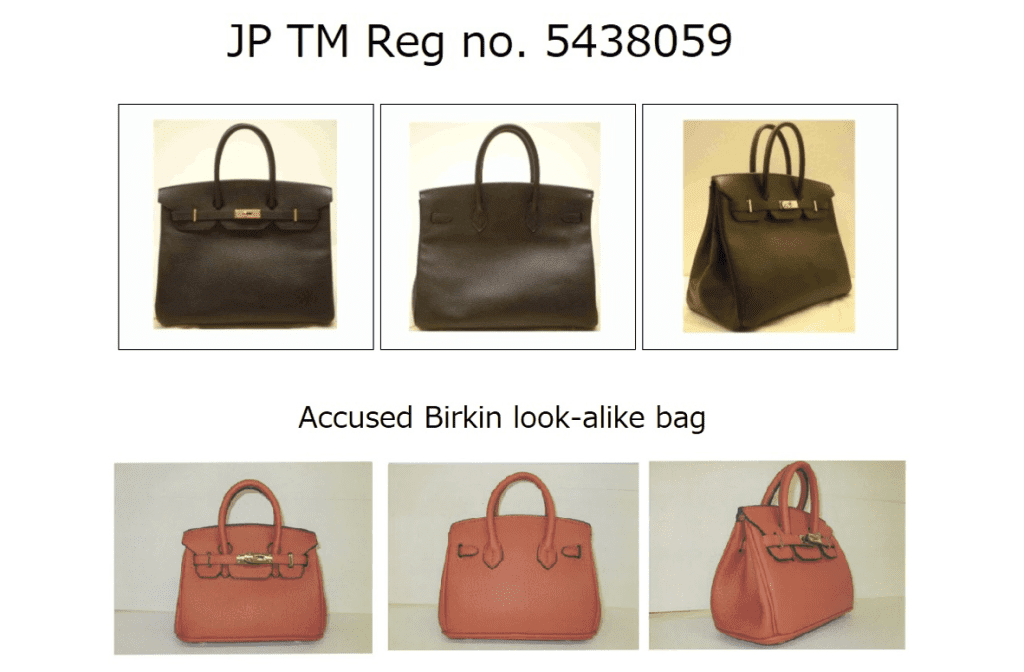Amid the ongoing MetaBirkins trademark fight over non-fungible tokens tied to digital images of fur-covered Birkin bags in the U.S., Hermès has prevailed in a separate Birkin-centric lawsuit that has been underway in Japan. In a decision dated March 9, the Civil Division of the Tokyo District Court sided with Hermès in the trademark infringement and unfair competition case, in which it accused NAO INTERNATIONAL Co., Ltd. of offering up handbags that mirror the well-known designs of its coveted Birkin and Kelly bags in its brick-and-mortar stores in Japan and its e-commerce site over the course of a more-than-two-year period between December 2019 and February 2021.
Laying the groundwork in its decision, the Tokyo District Court stated that an array of issues are on the table in connection with Hermès’ trademark infringement claim (under Article 709 of the Civil Code) and unfair competition claim (Article 4). The bulk of these issues center on: (1) the similarity between the shapes of the plaintiff’s trademark and the defendant’s goods; (2) whether there is a risk of consumer confusion; (3) whether or not the plaintiff’s trademark is used as a trademark; (4) the presence or absence of intention or negligence; and (5) the existence – and amount – of damage.
For a bit of background: Hermès successfully demonstrated that the three-dimensional shapes of its two most famed handbags have acquired secondary meaning in the market in Japan (and thus, are not merely common handbags shapes), resulting in registrations in 2011. Hermès’ Birkin trade dress consists of “the configuration of a handbag, having rectangular sides a rectangular bottom, and a dimpled triangular profile. The top of the bag consists of a rectangular flap having three protruding lobes, between which are two keyhole-shaped openings that surround the base of the handles. Over the flap is a horizontal rectangular strap having an opening to receive a padlock eye. A lock in the shape of a padlock forms the clasp for the bag at the center of the strap.”

Meanwhile, the French luxury goods brand’s Kelly bag trade dress encompasses “the configuration of a handbag, having trapezoidal sides, a rectangular bottom, and a dimpled triangular profile. The top of the bag consists of a rectangular flap having a protruding rectangular center portion that fits beneath a horizontal rectangular strap having an opening to receive a padlock eye. A lock in the shape of a padlock forms the clasp for the bag at the center of the strap.”
First considering the appearance of the two parties’ handbags, the court determined that any differences between them are “trivial” and thus, “there is no basis for denying their similarity.” The court shot down NAO’s arguments on this front, namely, that there a number of differences between its bags and Hermès’ bags, including variations in their size, materials, shape, etc.
As for likelihood of confusion, the court similarly sided with Hermès here, despite NAO’s claims to the contrary. Among other things, NAO argued that the differences in price between the companies’ bags was significant; Hermès’ products “are all high-end handbags, most of which sell for more than 1,000,000 yen [$7,560] per Birkin, and more than 500,000 yen [$3,780] for a Kelly,” whereas its bags sell for roughly 15,180 yen ($115). In addition to differences in the price tags, NAO argued that the likelihood of confusion is low, as its bags lack the Hermès branding that appears on authentic Birkin and Kelly bags, and it “never marketed [its] products as ‘Birkin style,’ ‘Kelly style,’ etc.,” and instead, “sold them as its own products.”
Still yet, NAO claimed that it is “a well-known fact that the purchasing demographics of [Hermès] products and [of its] products are different,” further lessening the potential for consumer confusion.
Unpersuaded by the price differentials at play here, the court determined that while “it goes without saying that the price difference is large,” there was still room for consumer confusion, particularly in light of the robust resale market. “Even though there is a severe price gap between the Hermès bags and [NAO’s] bags, Osaka-based trademark attorney Masaki Mikami stated that the court found that “such a price gap would be anything but sufficient to negate the likelihood of confusion,” since “the similarity between the shape of the [Hermès bag] trademarks and [NAO’s bags] cannot be denied.”
Finding the role of the resale market to be an important factor in the confusion analysis, the court here mirrored an earlier Birkin-centric decision from the Japan IP High Court, which noted the importance of the resale mark in its consideration of “the actual conditions of trade” for the parties’ products in a separate case waged by Hermès in 2020. While it is true that the “sales channels [for new Hermès bags] are relatively limited” to “directly-managed stores and specialty [Hermès] stores,” the court found in that case that it is significant that “a second-hand market has been established for used [Hermès] products … and that they are actively traded in [non-Hermès] stores and on the Internet.” The potential for confusion is also heightened, the court held, as “the origin and product name” of a product in a resale capacity “may not be as clear as [they are] for new products, and the transactions are conducted without sufficiently confirming the quality, product name, existence of logos, etc.”
Back to the case at hand, the court also dismissed NAO’s argument about the distinct pools of consumers, finding that it was as lacking in “credibility.”
In terms of use as a trademark, the court disagreed with NAO, finding that the Hermès trademarks at issue here “pertain to the shape of handbags, with the designated goods being handbags.” As such, “The sale of handbags that adopt the same or similar shape as [Hermès’ trademark-protected shapes] constitutes the use of a trademark in a manner that allows consumers to recognize that it is a product related to [a single source].” Since NAO sold handbags with a shape similar to each of the Hermès trademarks, the company’s trademarks were, in fact, used in a trademark capacity.
Finally, turning to the issues of damage and damages, the court determined that NAO’s sale of the infringing handbags caused damage to the Hermès brand value/reputation, as “in order to maintain its value and reputation as a luxury brand, [Hermès] strives to protect the quality of the products it manufactures and sells [and] its brand image by spending advertising expenses.” Against the background, the court awarded Hermès 1.5 million yen in connection with the intangible loss it suffered as a result of NAO’s infringement. The court also awarded Hermès 5.15 million yen, which is the amount of profit that NAO amassed due to its sale of the infringing handbags. And still yet, the court awarded Hermès reasonable attorney fees of 520,000 yen.
The case is Hermès International v. NAO INTERNATIONAL Co., Ltd., No. 22287.














